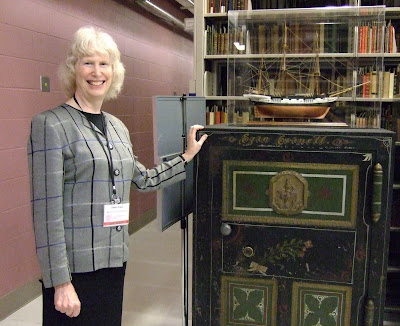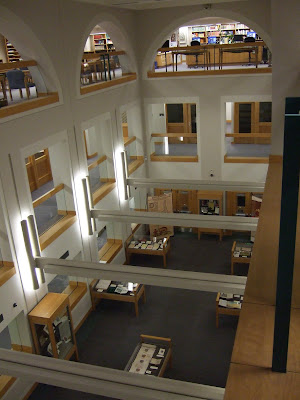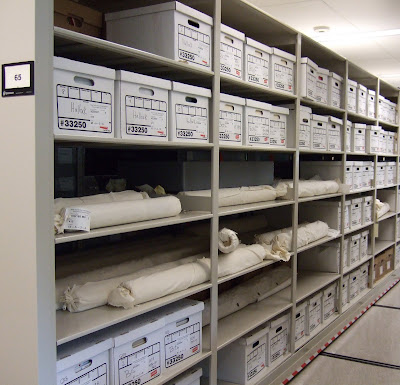Recently, I had the great pleasure of spending the day at Cornell University, where I interviewed Peter Hirtle, visited Curtis Lyons at the Catherwood Library), took a tour of the Rare and Manuscript Collections (RMC), and visited the Preservation department. My host for the RMC tour was Elaine Engst, whose entire title is Director and University Archivist at the Kroch Library Rare and Manuscript Collections at Cornell University. It was enormous fun seeing some of Cornell’s treasures, and I hope you’ll enjoy the photos and videos below, and be inspired to visit the collections yourself.
About the Archivist
Elaine Engst has been with Cornell for the entirety of her career, 32 years. She received her master’s in History from Cornell, returning to the Library in 1979.
She says that her favorite part of her work is “bringing the collections to students and scholars; the ‘puzzles’ of people’s research interests.” Of all the collections, she enjoys the Ezra Cornell Papers and the Willard Straight Papers the most. Cornell’s top her list because the University’s founder’s papers “cover the whole range of 19th century American history,” she explains. Straight’s papers “document China from 1901-1912” and include a “wonderful love story,” says Elaine.
 |
| From Cornell Visit July 2011 |
About the RMC
Elaine (shown above with Ezra Cornell’s safe) says, “RMC was created in 1992, with the merger of the Department of Manuscripts and University Archives, the Department of Rare Books, the History of Science Collections, and the Icelandic Collection.” The first librarian of the university, Daniel Willard Fiske was an avid collector of Icelandic literature, and now the collection which bears his name is one of the three largest of its kind in the world.
If you have never been to Cornell’s RMC, you might find it a little challenging to find it because it’s located in a library within a library. Which is to say that RMC lives in the Carl A. Kroch Library – built as an underground addition to the John M. Olin Library.
When visitors first enter the space, they are embraced by open, airy spaces and modern architecture, with natural light provided via skylights rimmed with reflective mirrors. On one side, the skylights are blocked to control light in the area for archival displays, while unblocked skylights on the other sheds more light for reading and research
 |
| From Cornell Visit July 2011 |
Within its very large, climate-controlled vault, the RMC holds approximately 430,000 volumes (measuring about 46,000 cubic feet); more than 80 million manuscripts; and another million photographs, paintings, prints, artifacts, audio visual and electronic media. In this short video, Elaine talks to me about the vault.
RMC is staffed by 22 full-time employees and 5-6 part-time working students. Eight archivists/librarians are on staff. Patrons run the gamut from serious scholars and students, to journalists, genealogists, and enthusiasts (like me). The archives are being used by long-term researchers currently exploring the history of home economics, as well as city planning. The RMC sees from 5-20 visitors per week, and the staffers give frequent tours, as I saw from the numerous signatures in the visitors’ book in front of the vault’s entryway.
The most heavily used collections are the Cornell Alumni Files. These are created by the Alumni office and are only open after the person has died. John Nolen’s papers also are used fairly frequently. Nolen was a pioneer city planner during the early 1900s. Cornell’s finding aid for the collection is here. The item with the greatest impact on visitors is the handwritten manuscript of Abraham Lincoln’s Gettysburg Address, dated February 29, 1864. According to the RMC Lincoln Presidency exhibit, the “Cornell University Library’s copy of Abraham Lincoln’s Gettysburg Address is one of five known copies in Lincoln’s hand, and the only copy owned by a private institution. The four other copies are owned by public institutions: two at the Library of Congress, one at the Illinois State Lincoln Presidential Library, and one in the Lincoln Bedroom at the White House.” I had the opportunity to see a facsimile because as Elaine says, “taking out the real one would require a Cornell Police presence.”
 |
| From Cornell Visit July 2011 |
Like my tour at Stevens Institute, I had the opportunity to see some very old records – cuneiform tablets.
 |
| From Cornell Visit July 2011 |
In the photo above, you can see five different tablets. The large one in the middle was an example of an adoption record from ca. 2250 BCE. In the short video below, Elaine explains why these tablets are so important, especially in teaching about archives.
Sometimes RMC receives donations from faculty members that represent moments of our more recent history. Below is a series of photos I took of RMC’s 2000 General Election Palm Beach County voting machine that Professor Stephen H. Hilgartner, a faculty member in Science & Technology Studies, purchased on EBay for his teaching research into voting technologies and later gave to the archives for posterity.
From the outside, the machine looks like a steel briefcase.
 |
| From Cornell Visit July 2011 |
Inside is a fully-contained voting booth.
 |
| From Cornell Visit July 2011 |
Remember that phrase “hanging chad?” The semi-punched holes shown below are examples of hanging chads from a voting punch chard.
 |
| From Cornell Visit July 2011 |
A voter would open a series of pages, then use the device in the lower right corner to punch the holes for the desired candidates.
 |
| From Cornell Visit July 2011 |
If you use the magnifying function in Picasa to take a look at the example punch cards, you can see that the demonstrator card was punched for several presidential candidates.
One of the most appealing aspects of visiting Cornell’s RMC is the great variety of the types of materials kept in the archives. Elaine showed me some Asia Collections records that were printed onto palm leaves. She also displayed an early example of a book that used both single and double column moveable type printing. Below, the photos show a 1495 book of sermons bound with a chain binding, the medieval security system.
 |
| From Cornell Visit July 2011 |
 |
| From Cornell Visit July 2011 |
I was especially impressed by the nifty box the Preservation Department made to accommodate the chain binding.
 |
| From Cornell Visit July 2011 |
Another type of record we hear of often in our field is lantern slides. You find them in pretty much every archive, and in the case of the Plainfield Public Library, they show up prominently in the photograph collections of local photographers. However, at Cornell, Elaine explains (in the video below) a completely different usage.
Elaine was very generous with her time and showed me many more treasures than what I’m sharing here (due to limited space). I hope that you will go visit her at Cornell and see some of these marvelous historical items for yourself.
Contact Information
Division of Rare and Manuscript Collections
2B Carl A. Kroch Library, Cornell University
Ithaca, NY 14853
(607) 255-3530
rareref@cornell.edu
http://rmc.library.cornell.edu

